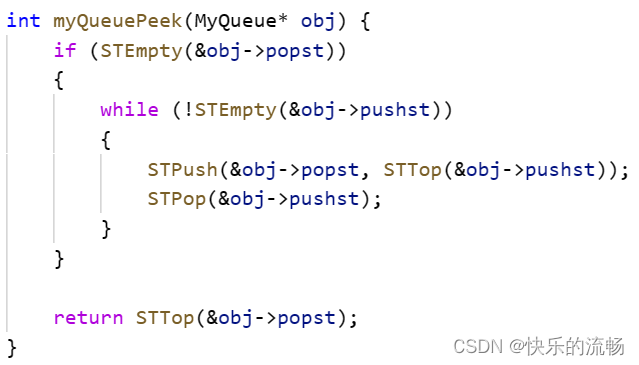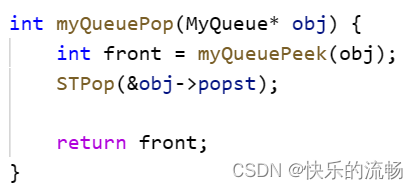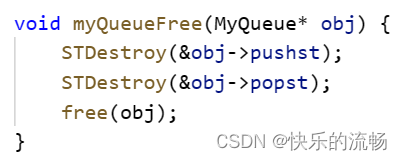
思路
思路:利用两个栈实现队列先进先出的特性,先将元素导入一个栈内

模拟出队时,则将所有元素导入另一个栈内,此时元素顺序被反转过来,只需要取栈顶数据即可

那我们就可以将两个栈的功能分开,一个专门入push,一个专门出pop。出数据时,如果popst为空,则将pushst的数据导入。
假设pushst入了1234后,反转到popst后,pushst又入了56,这时也是可以的。因为先pop4次,将1 2 3 4依次出栈,popst为空,则再将56导入,再pop2次,以5 6依次出栈。最终依然是1 2 3 4 5 6先入先出的顺序。

实现
实现: 因为C语言没有库可以现成使用,所以我们将写好的栈导入
先创建MyQueue结构体,包含两个栈结构体。再malloc动态申请MyQueue结构体的空间,最后将两个栈传入初始化函数,进行初始化(记得要加上&取地址符号)

入队过程 ,我们把数据全部导入pushst栈内即可

因为peek的功能比较简单,只用返回队列开头元素,所以我们先实现这个功能,等会实现pop再复用peek。
返回队列开头元素,我们的核心思路,先判断popst是否为空,如果为空,则循环将pushst中的元素全部导入popst(注意:每取出一个栈顶元素,就将该元素pop出栈),最后获取popst的栈顶元素即可

出队过程,复用peek的功能,先用front保存队头元素,再将popst的栈顶元素弹出,最后返回front即可

判断栈是否为空,只要当两个栈pushst和popst全为空时,队列才为空,返回true,否则返回false

最后,释放队列空间,可能有人只写了最后一句也给过了,但是其实这是不对的。正确做法是,先将两个栈都销毁(销毁数组),再将MyQueue空间给释放掉,这样才不会造成内存泄漏

完整代码附上:
typedef int STDataType;
typedef struct Stack
{
STDataType* a;
int top;
int capacity;
}ST;
//初始化
void STInit(ST* pst);
//销毁
void STDestroy(ST* pst);
//压栈
void STPush(ST* pst, STDataType x);
//出栈
void STPop(ST* pst);
//获取栈顶元素
STDataType STTop(ST* pst);
//检测栈是否为空
bool STEmpty(ST* pst);
//检测栈中有效元素个数
int STSize(ST* pst);
void STInit(ST* pst)
{
assert(pst);
pst->a = NULL;
pst->top = 0;//top指向栈顶元素的下一个位置
pst->capacity = 0;
}
void STDestroy(ST* pst)
{
assert(pst);
free(pst->a);
pst->top = pst->capacity = 0;
}
void STPush(ST* pst, STDataType x)
{
assert(pst);
if (pst->top == pst->capacity)
{
int newCapacity = pst->capacity == 0 ? 4 : pst->capacity * 2;
STDataType* tmp = (STDataType*)realloc(pst->a, newCapacity * sizeof(STDataType));
if (tmp == NULL)
{
perror("realloc fail");
return;
}
pst->a = tmp;
pst->capacity = newCapacity;
}
pst->a[pst->top++] = x;
}
void STPop(ST* pst)
{
assert(pst);
assert(!STEmpty(pst));
pst->top--;
}
STDataType STTop(ST* pst)
{
assert(pst);
assert(!STEmpty(pst));
return pst->a[pst->top - 1];
}
bool STEmpty(ST* pst)
{
assert(pst);
return pst->top == 0;
}
int STSize(ST* pst)
{
assert(pst);
return pst->top;
}
typedef struct {
ST pushst;
ST popst;
} MyQueue;
MyQueue* myQueueCreate() {
MyQueue* obj = (MyQueue*)malloc(sizeof(MyQueue));
if (obj == NULL)
{
perror("malloc fail");
return NULL;
}
STInit(&obj->pushst);
STInit(&obj->popst);
return obj;
}
void myQueuePush(MyQueue* obj, int x) {
STPush(&obj->pushst, x);
}
int myQueuePop(MyQueue* obj) {
int front = myQueuePeek(obj);
STPop(&obj->popst);
return front;
}
int myQueuePeek(MyQueue* obj) {
if (STEmpty(&obj->popst))
{
while (!STEmpty(&obj->pushst))
{
STPush(&obj->popst, STTop(&obj->pushst));
STPop(&obj->pushst);
}
}
return STTop(&obj->popst);
}
bool myQueueEmpty(MyQueue* obj) {
return STEmpty(&obj->pushst)
&& STEmpty(&obj->popst);
}
void myQueueFree(MyQueue* obj) {
STDestroy(&obj->pushst);
STDestroy(&obj->popst);
free(obj);
}
/**
* Your MyQueue struct will be instantiated and called as such:
* MyQueue* obj = myQueueCreate();
* myQueuePush(obj, x);
* int param_2 = myQueuePop(obj);
* int param_3 = myQueuePeek(obj);
* bool param_4 = myQueueEmpty(obj);
* myQueueFree(obj);
*/